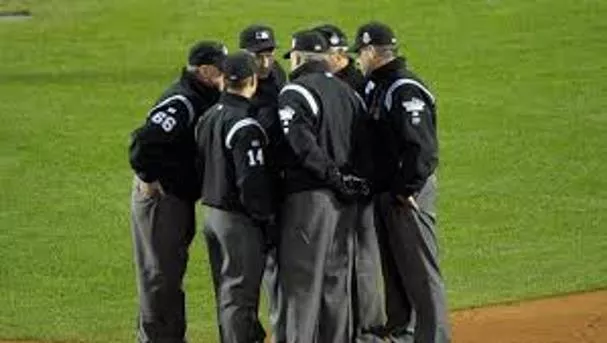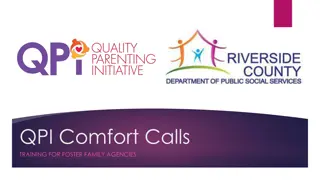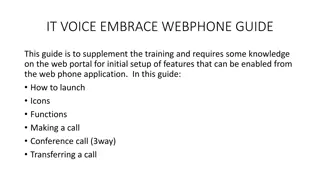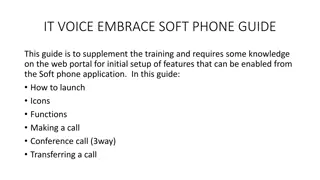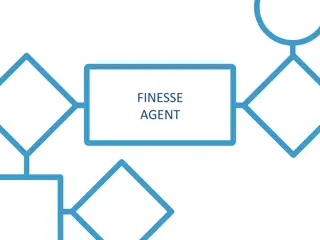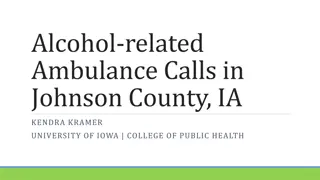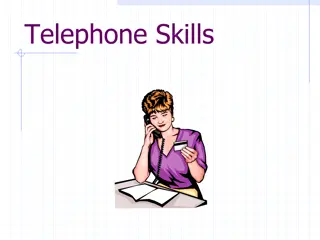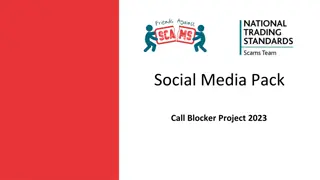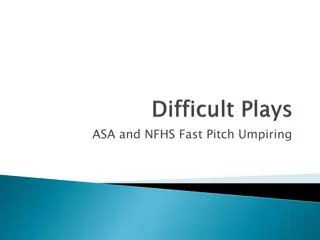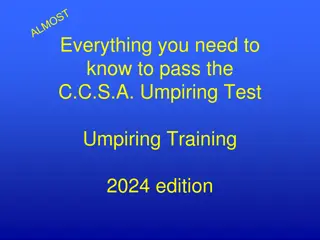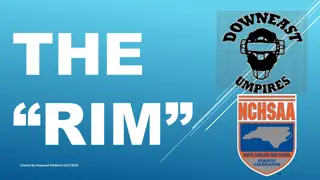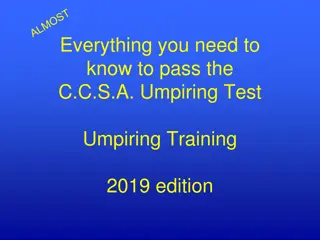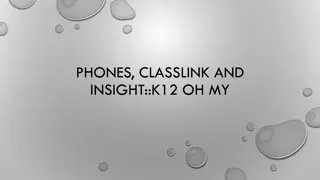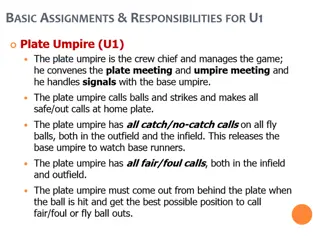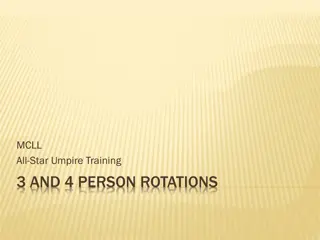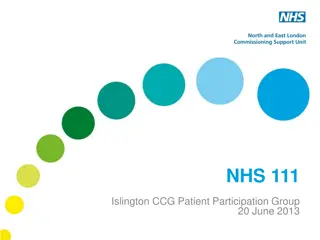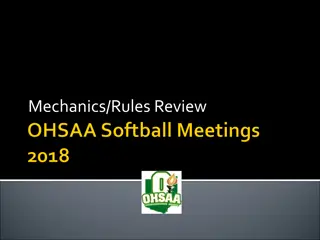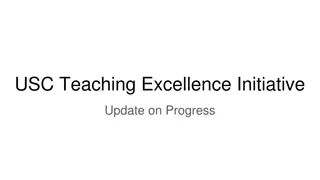Umpiring Excellence: Getting Help and Making Correct Calls
Umpires should strive for perfection in making correct calls by focusing on positioning, timing, rule mastery, and judgment. When help is needed due to blocked views or poor positioning, partnering with another umpire is crucial to ensure accurate calls. Certain calls, like force plays and balls/strikes, cannot be changed, while others, such as ball caught or dropped, allow for correction. Upholding standards of accuracy and collaboration is key to umpiring success.
Download Presentation

Please find below an Image/Link to download the presentation.
The content on the website is provided AS IS for your information and personal use only. It may not be sold, licensed, or shared on other websites without obtaining consent from the author. Download presentation by click this link. If you encounter any issues during the download, it is possible that the publisher has removed the file from their server.
E N D
Presentation Transcript
Getting Help when and how Prepared for District XI Chapter meeting 29 March 2021, by Mike Applegate, Rules Interpreter 1
Getting Help The absolute goal of every umpire should be to get EVERY call on EVERY play correct. However, umpires are humans and that absolute goal of perfection is hard to attain, even for the umpire at the MLB level. There is an old adage to the effect that everyone expects an umpire to be perfect from the start of the season and improve from there. But how do we strive for the goal? By working on the elements that go into making a correct call: Using Correct positioning from the start of the play to it s end (angle over distance); Employing Proper Timing (Proper use of eyes); Mastering and understanding the applicability of the rules; and Developing good judgment. 2
Getting Help When situations arise (e.g. view blocked or poor positioning) that prevent an umpire from seeing a crucial element of a play, help from a partner may be needed. But no umpire shall criticize or interfere with another umpire s decision unless asked by the calling umpire (Rule 10-1-4). This does not include the misinterpretation / misapplication of a rule (e.g. the wrong number of bases awarded, IFR with R1/R3, etc). When these situations occur it is IMPERATIVE that the calling umpire gets the needed help to GET THE CALL RIGHT . Conference with your partner and use any additional information provided to make the final decision. The original calling umpire is responsible for the ultimate final decision and notification through proper signaling. To live and die with the call is no longer an acceptable philosophy. If you are 100% positive and confident in your decision based upon your view of the play you do not have to seek help from your partner. 3
Getting Help Examples of calls that can be changed? Whether a ball bounced over a fence or went over in flight. Whether a batted ball left the field over fair or foul territory. A foul tip that is dropped / trapped or that first doesn t strike the catcher s hand / mitt. Ball dropped / juggled by a fielder after making a tag of a runner or a base. The Pitcher is not on the rubber when a balk is called. Cases of spectator interference. Catch / no catch of fair fly ball with no runners on base. Catch or trap of a FOUL fly ball. 4 Checked swings no swing to swing only! PU not obligated if he is positive of no swing .
Getting Help Calls involving Judgment alone CANNOT be changed. Rule 10-1-4 states that judgment decisions are final. Examples of plays that cannot be changed: Force plays at a base safe / out Balls / strikes Foul ball / fair ball Batter out of baseline Obstruction Illegally batted ball Tag plays on a runner Balks / Illegal pitches (on the rubber) Catcher Interference Running Lane Violation IFR (routine and ordinary effort by infielder) Ejections Some calls cannot be changed without creating additional problems changing catch / no catch with runner(s) on base. Where do you place runner(s)? 5
Getting Help Mechanics of getting help: Calling Umpire makes the call. If you are asked to get help and you there is some doubt in your decision, confer with your partner(s) privately away from coaches and players. Keep the conference short. Explain what you had. Ask your partner(s) for additional information. Use whatever information is provided to you to make a final decision. The calling umpire is responsible for signaling the final decision. No arguments. An explanation may be needed for the offended team if a call is reversed. Reversing a call should be the exception not the substitution for proper umpiring . There are times when U1 can go for help before making the call pulled foot / swipe tag at first base with no runners. PU is in position to help right away. 6
Getting Help Base Umpire helping the Plate Umpire: 1. Checked swings: Two things to consider a. Did the batter attempt to strike the ball? b. Did the bat cross the front (hip) of his body? If so then it s a swing. When asked Did he go? Reply Yes he did / No he didn t with a physical signal of a strike or safe. If the pitch is a dropped 3rd strike do not wait for the PU to come to you for help. If you judge a swing, an immediate YES he did is required to alert the batter that he has an opportunity to advance on the dropped 3rd strike. 2. Batted ball hits the batter (in / out of the box) allow the PU to make the call. If he doesn t make a call then as the BU call TIME and rule the play. Don t call foul. That s the PU s decision. It could have been an illegally batted ball, or he may have been out of the box, both resulting in an out, not a foul. HINT: if the batted ball goes straight to the ground and rolls into fair territory, it s highly likely that the batted ball hit his foot / leg. 7
Getting Help Q U E S T I O N S ? ? ? 8


